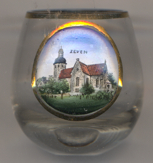

|
| DEUTSCHLAND | GERMANY |
| Bundesland: Niedersachsen | Lower Saxony |
| Landkreis: Rotenburg (Wümme) |
Zeven is situated at an elevation of 24 m in the Zevener Geest region approximately 44 km northeast of Bremen, 60 km southeast of Bremerhaven, 60 km southwest of Hamburg and 29 km northwest of the district towm, Rotenburg (Wümme). The municipality has a population of about 13,800 (2019).
Kivinan was first mentioned in AD 986 in a document from the nearby Benedictine vonvent in Heeslingen, which
was relocated to Zeven in 1149. The convent played a determining role in Zeven's history. Zeven belonged to the old Duchy
of Saxony and at its dissolution in 1180 Zeven became a part of the newly founded Prince-Archbishopric of Bremen. During
the Protestant Reformation the majority of the nuns clung to Catholicism, while most citizens adopted Lutheranism. At the
end of the Thirty Years' War (1618–1648), by the Peace of Westphalia the Prince-Archbishopric was transformed into
the Duchy of Bremen in 1648, which, together with the Principality of Verden, was first given to the Swedish Crown. The
queen regnant Christina of Sweden, in personal union Duchess of Bremen and Princess of Verden, installed in the two latter
functions her residence in today's Queen Christina House in Zeven, the oldest remaining profane building in town. After a
Danish occupation (1712–1715) the Duchy of Bremen was sold to the House of Hannover, and
thus became ruled in personal union with the Electorate of Hanover and the Kingdom of Great Britain. With British Hanover's
 defeat in the Napoleonic Wars the short-lived Kingdom of Westphalia annexed the Duchy of Bremen in 1807, including Zeven,
before France annexed it in 1810. In 1813 the Duchy was restored to the Electorate (1814 Kingdom) of Hannover. From 1866 on,
Zeven was part of the Prussian Province Hannover. The district Zeven was dissolved in 1932 and was merged into the district
Bremervörde. In 1965 the municipalities of Elsdorf, Gyhum, Heeslingen and Zeven combined their administrations in the
Samtgemeinde (collective municipality) Zeven.
defeat in the Napoleonic Wars the short-lived Kingdom of Westphalia annexed the Duchy of Bremen in 1807, including Zeven,
before France annexed it in 1810. In 1813 the Duchy was restored to the Electorate (1814 Kingdom) of Hannover. From 1866 on,
Zeven was part of the Prussian Province Hannover. The district Zeven was dissolved in 1932 and was merged into the district
Bremervörde. In 1965 the municipalities of Elsdorf, Gyhum, Heeslingen and Zeven combined their administrations in the
Samtgemeinde (collective municipality) Zeven.
The  church of St. Vitus was built most likely between 1141 and 1158. In 1867 it was
planned to demolish the church; however, the plan was not executed and the church eventually was restored in 1872.
church of St. Vitus was built most likely between 1141 and 1158. In 1867 it was
planned to demolish the church; however, the plan was not executed and the church eventually was restored in 1872.
[https://de.wikipedia.org/wiki/Zeven, https://en.wikipedia.org/wiki/Zeven;
https://de.wikipedia.org/wiki/Kloster_Zeven]
![[scale]](lineal.jpg)